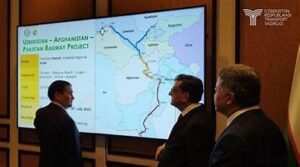The Trans-Afghan Corridor: A Strategic Pipeline for South and Central Asia

The global geopolitical landscape is ever-shifting, and at the heart of a new potential pivot is the Trans-Afghan Corridor. Recently, Russian Security Council Secretary Sergei Shoigu announced that Russia would remove the Islamic Emirate of Afghanistan (IEA) from its blacklist status, fueling speculation about an ambitious trade and transportation initiative that could redefine connections across South and Central Asia.
What Exactly is the Trans-Afghan Corridor?
The Trans-Afghan Corridor is a proposed railway service designed to bridge Afghanistan with strategic ports in Uzbekistan and Pakistan. Spanning approximately 573 kilometers, this corridor is projected to cost between $4.8 billion and $6.9 billion, with construction slated to kick off in 2025.
One of the most groundbreaking aspects of this initiative is its potential to expedite cargo transit. Currently, it takes cargo from Uzbekistan to Pakistan over 35 days, but this innovative railway could reduce that time to just 3 to 5 days. Alongside rail transport, the corridor will include road services, effectively creating a multi-modal transport highway for participating nations.
The project boasts participation from a diverse cohort of countries including Kazakhstan, Turkmenistan, Uzbekistan, Afghanistan, Pakistan, Russia, and Belarus, making it a linchpin for regional cooperation.
The Opportunities and Challenges
While the prospects of the Trans-Afghan Corridor are enticing, several challenges loom large. For this plan to succeed, Afghanistan and Pakistan must maintain robust diplomatic relations. Additionally, the country’s harsh and varied landscape, coupled with extreme weather conditions, could complicate operations along the corridor.
Pakistan, in particular, will need rapid upgrades to its infrastructure, an urgent concern given the nation’s ongoing economic struggles. Security remains another significant point of apprehension, as various extremist groups continue to operate in the region, posing risks to all partners involved.
Russia’s Role and Implications
Interestingly, Russia is positioned to provide the lion’s share of financial backing for this monumental project. By supporting the corridor, Russia aims to solidify its influence throughout South and Central Asia, further extending its reach in a region rich in untapped natural resources, including mining and agriculture.
Despite the Taliban’s controversial status—and the skepticism surrounding their governance since the U.S. withdrawal in 2021—the group has been attempting to maintain governance while facing overwhelming economic collapse, with over 90% of the population encountering food insecurity. Their reliance on foreign backing from countries like China and Russia only adds complexity to regional dynamics.
The China Factor
China’s Belt and Road Initiative (BRI) poses yet another layer of competition in the area. Although Beijing does not formally recognize the Taliban as a legitimate government, it has expressed interest in investing in Afghanistan, complicating the international response to the emerging political landscape.
Estimates indicate that the Trans-Afghan Corridor could be operational by 2030, a year that many experts predict will be pivotal for geopolitical shifts. As Russia officially partners with the IEA, the international community is gearing up for heated debates surrounding legitimacy, governance, and regional stability.
Why Extreme Investor Network?
At Extreme Investor Network, we don’t just report on economic trends—we analyze them, offering our readers insights that can shape investment strategies in emerging markets. The ongoing developments surrounding the Trans-Afghan Corridor exemplify the intricate interplay between geopolitical ambitions and economic potential. Understanding these factors is crucial for investors and stakeholders looking to navigate the waters of international trade.
Stay informed with us as we continue to track and analyze this evolving situation, providing you with the tools and foresight needed to make well-informed decisions in the ever-changing world of economics.

